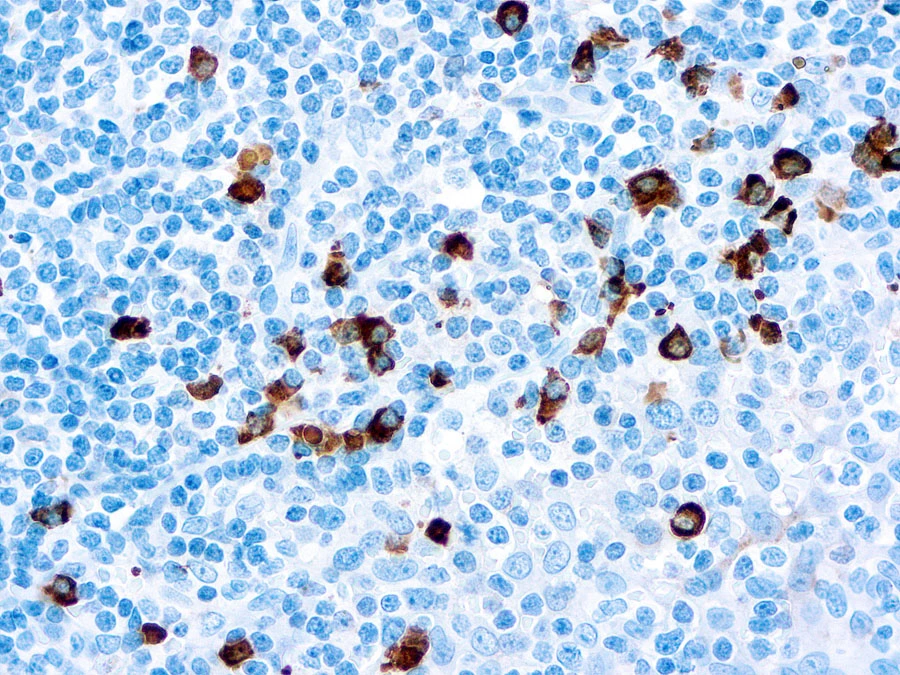
IHC-P analysis of human tonsil tissue using GTX20937 Human IgA antibody (ready-to-use).
Rabbit Anti-Human IgA antibody (ready-to-use)
GTX20937
ApplicationsImmunoHistoChemistry, ImmunoHistoChemistry Paraffin
Product group Antibodies
ReactivityHuman
TargetIGH
Overview
- SupplierGeneTex
- Product NameHuman IgA antibody (ready-to-use)
- Delivery Days Customer9
- Antibody SpecificityThis antibody reacts with α-chains of human IgA. This antibody has been adsorbed to a very high level of specificity.
- Application Supplier Note*Optimal dilutions/concentrations should be determined by the researcher.Not tested in other applications.
- ApplicationsImmunoHistoChemistry, ImmunoHistoChemistry Paraffin
- CertificationResearch Use Only
- ClonalityPolyclonal
- ConjugateUnconjugated
- Gene ID3492
- Target nameIGH
- Target descriptionimmunoglobulin heavy locus
- Target synonymsD (diversity) region of heavy chains; IGD1; IGH.1@; IGH@; IGHD@; IGHDY1; IGHJ; IGHJ@; IGHV; IGHV@; immunglobulin heavy chain variable region; immunoglobulin heavy diversity cluster; immunoglobulin heavy diversity group; immunoglobulin heavy diversity locus; immunoglobulin heavy joining cluster; immunoglobulin heavy joining group; immunoglobulin heavy polypeptide, joining region; immunoglobulin heavy variable cluster; immunoglobulin heavy variable group; J (joining) region of heavy chains
- HostRabbit
- IsotypeIgG
- Scientific DescriptionImmunoglobulins recognize foreign antigens and initiate immune responses such as phagocytosis and the complement system. Each immunoglobulin molecule consists of two identical heavy chains and two identical light chains. This region represents the germline organization of the heavy chain locus. The locus includes V (variable), D (diversity), J (joining), and C (constant) segments. During B cell development, a recombination event at the DNA level joins a single D segment with a J segment; this partially rearranged D-J gene is then joined to a V segment. The rearranged V-D-J is then transcribed with the IGHM constant region; this transcript encodes a mu heavy chain. Later in development B cells generate V-D-J-Cmu-Cdelta pre-messenger RNA, which is alternatively spliced to encode either a mu or a delta heavy chain. Mature B cells in the lymph nodes undergo switch recombination, so that the V-D-J gene is brought in proximity to one of the IGHG, IGHA, or IGHE genes and each cell expresses either the gamma, alpha, or epsilon heavy chain. Recombination of many different V segments with several J segments provides a wide range of antigen recognition. Additional diversity is attained by junctional diversity, resulting from the random addition of nucleotides by terminal deoxynucleotidyltransferase, and by somatic hypermutation, which occurs during B cell maturation in the spleen and lymph nodes. Due to polymorphism, the numbers of functional V, J, and D genes differ among individuals and some V, D, J, and C segments may be pseudogenes. [provided by RefSeq, Dec 2017]
- ReactivityHuman
- Storage Instruction2°C to 8°C
- UNSPSC12352203
References
- Evaluation of the Relationships between Intestinal Regional Lymph Nodes and Immune Responses in Viral Infections in Children. Aoki Y et al., 2021 Dec 28, Int J Mol SciRead more
